I'm don't know how to get focused item automatically change within a ListView.
I would like the focused item in the view to automatically change when I change the "IsSelected" property to an other element in the databinded list:
When an item is modified by PC/SC card reader (see this as input), the next element should be focused like this:
I would like to stay in MVVM and therefor not having View referenced in the ViewModel. Below is my current code.
Model : The main purpose is to extend a DTO with an IsSelected property and implementing INotifyPropertyChanged
public class SmartDeviceModel : INotifyPropertyChanged
{
public bool IsSelected;
private DtoReader _dtoReader;
public SmartDeviceModel(DtoReader _reader)
{
_dtoReader = _reader;
}
public string DisplayName => _dtoReader.DisplayName;
public string Uid
{
get
{
return _dtoReader.Uid;
}
set
{
_dtoReader.Uid = value;
OnPropertyChanged("Uid");
}
}
public long RadioId
{
get
{
return _dtoReader.RadioId : _dtoMarker.RadioId;
}
set
{
_dtoReader.RadioId = value;
OnPropertyChanged("RadioId");
}
}
public event PropertyChangedEventHandler PropertyChanged;
protected void OnPropertyChanged(string name)
{
PropertyChanged?.Invoke(this, new PropertyChangedEventArgs(name));
}
}
ViewModel received events of a PC/SC card reader to pair data from RFID chip with current selected item. When RFID chip is removed from PC/SC Reader, the next element is well selected but got not focused.
public class ScanDeviceViewModel : BaseViewModel
{
public BindingList<SmartDeviceModel> ReaderList { get; }
public int SelectedReaderIndex;
private ITagReaderInput _rfidReader;
public ScanDeviceViewModel()
{
//Get Data listener for RFID Tag
_rfidReader = new IdentivTagReader.IdentivTagReader();
// Data Source of DTO
SiteInteractor siteInterractor = new SiteInteractor();
// List used for DataBinding
ReaderList = new BindingList<SmartDeviceModel>();
foreach (DtoReader m in SiteInteractor.GetReaders().OrderBy(x => x.DisplayName))
{
ReaderList.Add(new SmartDeviceModel(m));
}
if (ReaderList.Count() > 0)
{
for (var i = 0; i < ReaderList.Count(); i++)
{
if (String.IsNullOrEmpty(ReaderList[i].Uid))
{
SelectedReaderIndex = i;
ReaderList[i].IsSelected = true;
break;
}
}
}
_rfidReader.LabelDetected += RfidTagDetected;
_rfidReader.LabelRemoved += RfidRemoved;
}
private void RfidTagDetected(ITagLabel tag)
{
if (ReaderList[SelectedReaderIndex] != null && string.IsNullOrEmpty(ReaderList[SelectedReaderIndex].Uid))
{
ReaderList[SelectedReaderIndex].IsSelected = true;
ReaderList[SelectedReaderIndex].Uid = tag.Uid;
ReaderList[SelectedReaderIndex].RadioId = tag.RadioId;
}
}
private void RfidRemoved(ITagLabel tag)
{
if (ReaderList[SelectedReaderIndex].Uid == tag.Uid)
{
ReaderList[SelectedReaderIndex].IsSelected = false;
while (ReaderList.Count >= SelectedReaderIndex + 1)
{
SelectedReaderIndex++;
if (String.IsNullOrEmpty(ReaderList[SelectedReaderIndex].Uid)){
ReaderList[SelectedReaderIndex].IsSelected = true;
break;
}
}
}
}
}
View I'm using a "Setter" using databinding to my model property "IsSelected" as suggested here but I most missed something else I don't understand yet.
<ListView ItemsSource="{Binding ReaderList}"
Margin="5" x:Name="listViewReader" SelectionMode="Single"
<ListView.ItemContainerStyle>
<Style TargetType="{x:Type ListViewItem}">
<Setter Property="BorderBrush" Value="LightGray" />
<Setter Property="BorderThickness" Value="0,0,0,1" />
<Setter Property="IsSelected" Value="{Binding IsSelected}" />
</Style>
</ListView.ItemContainerStyle>
<ListView.ItemTemplate>
<DataTemplate>
<Viewbox Grid.Row ="0" Stretch="Uniform" HorizontalAlignment="Left" VerticalAlignment="Bottom" MaxHeight="90">
<Grid>
<Grid.ColumnDefinitions>
<ColumnDefinition Width="*"/>
<ColumnDefinition Width="*"/>
</Grid.ColumnDefinitions>
<Grid.RowDefinitions>
<RowDefinition Height="2*" />
<RowDefinition Height="*"/>
</Grid.RowDefinitions>
<Label Content="{Binding DisplayName}" />
<DockPanel Grid.Row="1">
<Label Content="UID"/>
<Label Content="{Binding Uid}"/>
</DockPanel>
<DockPanel Grid.Row="1" Grid.Column="1">
<Label Content="RadioID" />
<Label Content="{Binding RadioId}"/>
</DockPanel>
</Grid>
</Viewbox>
</DataTemplate>
</ListView.ItemTemplate>
</ListView>
I tried several approach like this answer, although item is well selected, it is not focused.

